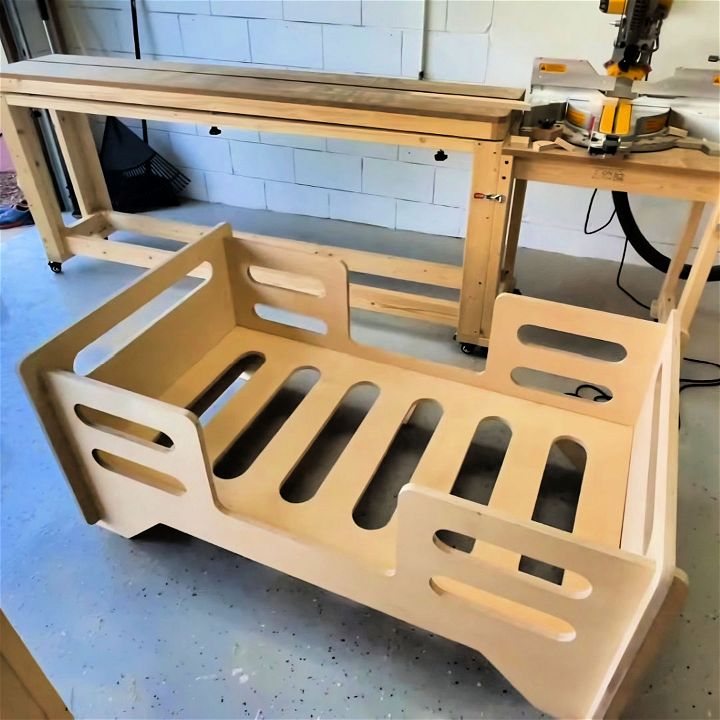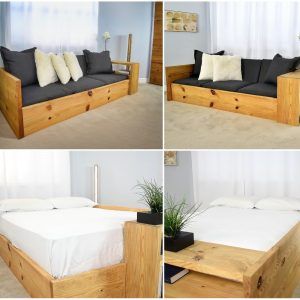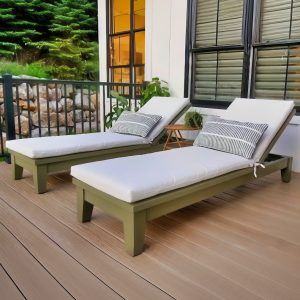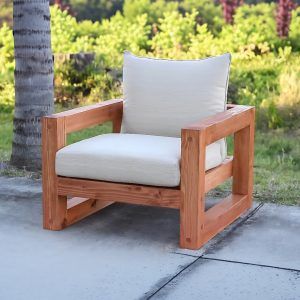Making a DIY toddler bed from a single sheet of plywood is a cost-effective project for any DIY enthusiast, especially if you’re starting a kids’ room renovation. With this step by step guide, you’ll be able to construct a durable and stylish toddler bed that not only saves space but also matches your child’s room decor perfectly. Let’s dive into the steps to make this project a success.

Materials and Tools Needed
- 1 sheet of Baltic birch plywood
- Circular saw
- Jigsaw
- Router with a pattern bit
- Sandpaper (80 grit and 150 grit)
- Orbital sander
- Drill
- Hammer and chisel
- Miter saw
- Osmo Polyx oil
- Mineral spirits or tack cloth
- Measuring tape
- Pencil
- Sanding block
- Clamps
- Disposable rags
- White Scotch Brite pad
Step-by-Step Guide
Planning and Design
- Sketch Your Design: Before cutting into your plywood, plan your design carefully. Draw or trace your design onto the plywood. Consider using cardboard to make a template first to ensure the size and fit are right for your space.
Cutting the Plywood
- Cut the Plywood: After finalizing your design, start cutting the plywood sheet in half, then proceed with the width-wise cuts. Remember to tape over the line you’re cutting to prevent chipping.
- Adjust Blade Height: When using the circular saw, set the blade height to just a half-tooth above the material thickness for a cleaner cut.
- Cut Out the Main Pieces: Next, cut the headboard, footboard, and side pieces according to your design. Use a jigsaw for rounded corners and curves, ensuring your cuts are perpendicular to the surface.
Assembling the Bed Frame
- Router Work: Use a pattern router bit to create duplicates of each piece for symmetry. This ensures that the headboard, footboard, and side pieces match exactly.
- Create Slots and Joints: To assemble the frame, you’ll need to cut slots for the headboard and footboard to slot into the sides. Use a chisel and hammer for precision and ensure the cuts are even.
- Sanding: Once all pieces are cut, sand every piece starting with an 80 grit pad on the orbital sander, smoothing out any rough edges. A handmade sanding block can help with manual adjustments.

Finishing Touches
- Assemble the Bed Frame: Before final assembly, make sure to clean up any dust from sanding. Assemble the bed frame by slotting the headboard and footboard into the side pieces.
- Apply Finish: Disassemble the frame for easier finishing. Use Osmo Polyx oil for a durable and child-friendly finish. Apply with a white Scotch Brite pad, let dry, and apply a second coat if necessary.
- Reassemble and Final Checks: After the finish has dried, reassemble the bed frame. Test the bed’s stability by applying gentle pressure to ensure it’s sturdy and safe for your toddler.
Video Tutorial
For a step-by-step video tutorial on making a toddler bed with a sheet of plywood, watch this helpful YouTube video by Breakwood Carpentry.
It pairs well with this written guide, providing a visual perspective to complement the techniques outlined here.
Maintenance and Upkeep
Keeping your DIY toddler bed in top condition is essential for safety and longevity. Here’s how to maintain it:
- Regular Checks: Every month, inspect the bed for loose screws or worn parts. Tighten and replace as needed.
- Cleaning: Wipe the bed frame with a damp cloth. Use mild soap for sticky spots. Avoid harsh chemicals.
- Protective Finish: Reapply a non-toxic sealant or finish yearly to protect the wood from moisture and wear.
- Mattress Care: Vacuum the mattress regularly. Use a waterproof cover to protect it from spills and accidents.
By following these simple steps, you can ensure your toddler bed remains a safe and cozy haven for your child.
Transitioning Tips
Moving to a toddler bed is a big step. Here’s how to make it smooth:
- Involve Your Child: Let them pick out sheets or a small pillow to make the bed feel special.
- Routine: Keep a consistent bedtime routine to help your child feel secure.
- Comfort Items: Allow a favorite toy or blanket in bed for extra comfort.
- Patience: Be patient. It may take time for your child to adjust to the new bed.
With these tips, transitioning to a toddler bed can be a positive experience for both you and your child.
Safety Guidelines and Standards
When creating a DIY toddler bed, safety is the paramount concern. Here’s how you can ensure the bed is both safe and comfortable for your little one:
- Choose Safe Materials: Use solid wood like pine or oak or a high quality playwood sheet, which are sturdy and free from chemicals. Avoid using pressure-treated lumber, as it may contain harmful substances.
- Smooth Edges: Sand all edges and surfaces to prevent splinters or cuts. Rounded corners are especially important to prevent bumps.
- Secure Rails: Install guard rails that are at least 22 inches above the mattress to prevent falls, and ensure they are firmly attached to the bed frame.
- Stable Construction: Make sure all joints are tightly fitted and reinforced with screws or bolts, not just glue or nails.
- Non-toxic Finish: Use natural, water-based paints or stains that are labeled as non-toxic, ensuring a safer sleeping environment.
Budget-Friendly Tips
Building a toddler bed doesn’t have to break the bank. Here are some cost-effective strategies:
- Repurpose Materials: Look for gently used wood or furniture that can be repurposed. Old dressers can be transformed into bed frames with a bit of creativity.
- Shop Sales: Purchase materials during sales or use coupons to get discounts on tools and supplies.
- Borrow Tools: Instead of buying, borrow tools from friends or rent them to save money.
- DIY Bedding: Consider making your own bedding from affordable fabrics instead of buying expensive sets.
- Community Resources: Check if local community centers offer free workshops or tool-lending libraries.
With careful planning and effort, you can build a beautiful DIY toddler bed that ensures sweet dreams without stretching your budget.
Customization Ideas for Your DIY Toddler Bed
Making a toddler bed is not just about building a piece of furniture; it’s about creating a personal and comfortable space for your child. Here are some ideas to add a personal touch to your DIY toddler bed:
- Theme: Choose a theme that your child loves. Whether it’s a favorite color, cartoon character, or a nature-inspired theme, incorporating these elements can make the bed more inviting.
- Paint: Use child-safe paint to add designs or patterns. Stencils can help create neat shapes or characters.
- Decals and Stickers: If you’re not confident about painting, decals are an easy alternative. They come in various designs and are simple to apply and remove.
- Interactive Elements: Consider adding a small chalkboard on the bed frame or a fabric pocket for books to encourage learning and creativity.
- Personalized Headboard: Craft a headboard that spells out your child’s name or a favorite quote with wooden letters or fabric appliqués.
- DIY Canopy: Create a canopy with light fabrics for a whimsical touch. It can also double as a reading nook.
- Under-Bed Storage: Utilize the space under the bed for storage. Add rolling bins for toys or build-in drawers to keep the room organized.
- Growth Chart: Integrate a growth chart into the bed frame design, so it’s not just a bed but a keepsake of your child’s growth.
These customization ideas can help turn a simple toddler bed into a cherished piece of childhood.

FAQs About DIY Toddler Bed Using Just One Sheet of Plywood
When building a toddler bed using just one sheet of plywood, it’s natural to have questions. Here are some FAQs to guide you through the process:
What inspired the design of this DIY toddler bed?
The design was crafted to accommodate families looking for a toddler bed that is strong, easy to move, and looks amazing. It’s particularly suited for situations where room flexibility is needed, like transitioning a child’s room to a guest room when company arrives.
Does this bed require screws or glue for assembly?
No, the bed’s design is unique in that it requires neither screws nor glue for assembly. This innovative approach raises questions about its sturdiness and whether it can hold together without creaking. Rest assured, the construction is solid and has been tested to be reliable and creak-free.
What type of plywood is best for a toddler bed?
Look for a high-grade, furniture-quality plywood like Baltic birch. It’s sturdy and has a smooth finish, which is ideal for painting and ensures safety.
How thick should the plywood be?
A thickness of ¾ inch is recommended. It provides enough strength to support a toddler’s weight without being too heavy.
Can I make a toddler bed from one sheet of plywood?
Yes, with careful planning and design, you can create a simple yet functional toddler bed from a single sheet of plywood.
Do I need advanced woodworking skills?
Not necessarily. Basic skills like measuring, cutting, and drilling are sufficient for a simple design. There are many tutorials available that can guide you through the process.
How do I ensure the bed is safe?
Sand all edges until they are smooth, avoid using toxic finishes, and ensure the bed frame is sturdy. Follow safety guidelines like those provided by the Consumer Product Safety Commission.
What tools will I need?
The essential tools include a saw for cutting the plywood, a drill for making holes, sandpaper for smoothing edges, and a paintbrush if you wish to paint the bed.
How can I customize the bed?
Personalize the bed with paint, stickers, or by adding a headboard with your child’s name. The design can be as simple or complex as you wish.
How do I make the most out of the plywood sheet?
Use a design that minimizes waste. Plan your cuts carefully and consider using any leftover pieces for a matching shelf or storage bins.
What material is recommended for making this toddler bed?
The project utilizes a birch plywood sheet for its construction. Baltic birch is known for its strength, flexibility, and the smooth finish it offers, making it an ideal choice for furniture making, especially for a toddler’s bed.
What are the side heights of this toddler bed?
The side heights, especially for the end pieces, have been mentioned to be about 23″. This measurement is vital for ensuring that the bed provides sufficient safety and containment for a resting child.
Is this design sturdy enough for an active toddler?
Yes, the design has been carefully crafted to ensure sturdiness without the use of screws or glue. This means it can reliably support an active toddler without the risk of collapsing or creaking, maintaining a safe sleeping environment.
Is this toddler bed design suitable for beginners in DIY projects?
Absolutely, this project is praised for its simplicity in design and assembly, making it an excellent choice for DIY beginners. The lack of screws or glue in its construction also means there’s less room for error, allowing for a more straightforward and enjoyable building experience.
If you have any more questions or need further assistance, feel free to ask!
Conclusion
Making a DIY toddler bed from scratch can be a rewarding project. With the right tools, detailed planning, and a bit of creativity, you can build a safe and comfortable bed that fits perfectly in your child’s room. This project not only adds a personal touch to your home but also showcases your DIY skills. Happy building!




